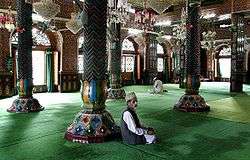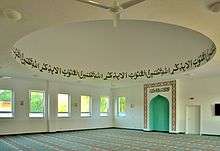Islam and gender segregation
Gender segregation in Islamic law, custom, law and traditions refers to the practices and requirements in Islamic countries and communities for the separation of men and boys from women and girls in social and other settings. Scholars differ as to whether the Qur'an requires gender segregation, and, if so, the hadith that require it.[1][2][3][4][3][5] There are diverging opinions among experts in Islamic theology concerning gender segregation.
| Part of a series on |
| Islamic jurisprudence (fiqh) |
|---|
 |
|
| Islamic studies |
Views
There are diverging opinions among experts in Islamic theology concerning gender segregation.
There have been fatwas which forbid free mixing between men and women (known as Ikhtilat), when alone. The objective of the restrictions is to keep such interaction at a modest level. According to Islamic edicts, men are not permitted to touch any part of the body of the women, whether she is Muslim or non-Muslim.[6] Islamic jurisprudence laws have traditionally ruled that Muslim men and women who are not immediate relatives may not, for instance, socialize in order to know each other with a handshake and any form of contact which involves physical contact.[7][8][9]
A number of Muslim intellectuals and Muslim scholars have challenged this view and claim that certain physical contact is permissible as long as there is no obscenity, inappropriate touching (other than a simple handshake), secret meetings or flirting, according to the general rules of interaction between the genders.[10]
Sources
The Qur'anic verses which address the interaction of men and women in the social context include:
Tell the believing men to lower their gaze and to be mindful of their chastity: this will be most conducive to their purity – (and,) verily, Allah is aware of all that they do. And tell the believing women to lower their gaze and to be mindful of their chastity, and not to display their charms beyond what may be apparent thereof; hence let them draw their veils over their bosoms and do not show their adornments except to their husbands or their fathers or their husbands' fathers or their sons or their husbands' sons or their brothers or their brothers' sons or their sisters' sons or their women or what their right hands possess or male servants free of sexual desires or those children who never knows the private things of women; and do not stamp their feet so that it may show their hidden adornments; and repent towards God collectively O believers so that you may succeed.
O Prophet, tell your wives and your daughters and the women of the believers to bring down over themselves [part] of their outer garments. That is more suitable that they will be known and not be abused. And ever is Allah Forgiving and Merciful.
Muhammad specifically admonished the men not to keep their wives from going to the mosques:
Ibn Umar (Abdullah bin Umar) reported what is translated as:
The Messenger of God said, "Do not prevent the maid-servants of God from going to the mosque."
— Muslim, No.888 (See also Nos. 884-891 and Bukhari Vol.1, Nos. 824, 832)
In Islamic countries
 |
| Part of a series on |
| Islamic culture |
|---|
| Architecture |
| Art |
|
| Dress |
| Holidays |
|
| Literature |
|
| Music |
| Theatre |
|
Afghanistan
Afghanistan, under Taliban religious leadership, was characterized by feminist groups and others as a "gender apartheid" system where women are segregated from men in public and do not enjoy legal equality or equal access to employment or education. In Islam women have the right to equal access to employment and education, although their first priority should be that of the family. Men too are said to be actively involved in the child rearing and household chores. Muhammad helped his wives in the house.[13][14]
In 1997 the Feminist Majority Foundation launched a "Campaign to Stop Gender Apartheid in Afghanistan", which urged the United States government and the United Nations to "do everything in their power to restore the human rights of Afghan women and girls." The campaign included a petition to U.N. Secretary General Kofi Annan and U.N. Assistant Secretary General Angela King which stated, in part, that "We, the undersigned, deplore the Taliban's brutal decrees and gender apartheid in Afghanistan."[15]
In 1998 activists from the National Organization for Women picketed Unocal's Sugar Land, Texas office, arguing that its proposed pipeline through Afghanistan was collaborating with "gender apartheid".[16] In a weekly presidential address in November 2001 Laura Bush also accused the Taliban of practicing "gender apartheid".[17] The Nation referred to the Taliban's 1997 order that medical services for women be partly or completely suspended in all hospitals in the capital city of Kabul as "Health apartheid".[18]
According to the Women's Human Rights Resource Programme of the University of Toronto Bora Laskin Law Library "Throughout the duration of Taliban rule in Afghanistan, the term "Gender Apartheid" was used by a number of women's rights advocates to convey the message that the rights violations experience by Afghan women were in substance no different than those experienced by blacks in Apartheid South Africa."[19]
Iran
When Ruhollah Khomeini called for women to attend public demonstrations and ignore the night curfew, millions of women who would otherwise not have left their homes without their husbands' and fathers' permission or presence, took to the streets. After the Islamic revolution, however, Khomeini publicly announced his disapproval of mixing between the sexes.[20]
Critics have argued that the restriction of women's rights under Islamic law has led to the segregation of public and private spaces, which they must then attempt to resolve through politics and creating their own spaces.[21] Gender segregation also impacts the company that people keep, as researcher Ziba Mir-Hosseini noted that during her field work she spent most of her time around women and that in some instances she never met the male relatives of some of these women due to the strict regulation of gender segregation.[22] These restrictions may also impact travel, as some rules state that married women are forbidden from traveling without their husband's permission and in some cases women must be segregated from male passengers.[23]
Saudi Arabia
In Saudi Arabia, male doctors were previously not allowed to treat female patients, unless there were no female specialists available; and it was also not permissible for women to treat men.[24] This has changed, however, and it is not uncommon for men and women to visit doctors of the opposite sex.
Critics have argued that the restriction of women's rights under Saudi Arabia law, which is based on sharia law, has led to the separation of gender as women and men are separated in almost all areas, from women-only fast food lines to women-only offices. These laws and policies are enforced by the Islamic religious police, which has prompted some to find ways to evade policing.[25] Gender segregation also impacts the Saudi education system, as there are more opportunities for men to graduate with a career and find employment. Women do not share in these opportunities and have a more difficult time finding employment as there are only a small amount of locations that permit men and women to mix.[26] Gender segregation also impacts the participation of women in religion by encouraging women to pray at home and not in the mosque. Scholars have stated that despite these restrictions, changes brought about with the new generations have allowed women more freedom to choose whether they pray at the mosque or in their homes.[27]
Mandate Palestine
Of the late 19th and early 20th century European Jewish immigration to Palestine, Norman Rose writes that secular "Zionist mores" were "often at odds with Arab convention, threatening the customs and moral assumptions that lent cohesion to a socially conservative, traditional Palestinian society."[28] The active political role of the women of the Yishuv, and their lack of segregation, was judged as particularly offensive.[29]
In mosques
Some schools of thought say that women should be encouraged to pray at home rather than in a mosque. However, other schools prefer to look at the context of the sayings, which they suggest were given at a time when women were in danger when leaving their homes, and consider mosques as welcome for women as their homes. Muhammad did not forbid women from entering his mosque in Medina. In fact, he told Muslims "not to prevent their women from going to mosque when they ask for permission".[30]
However, segregation of sexes in mosques and prayer spaces is reported in a hadith in Sahih Muslim, one of the two most authentic Hadith books in Islam. It says that the best rows for men are the first rows, and the worst ones the last ones, and the best rows for women are the last ones and the worst ones for them are the first ones.[31]
It is also recorded that Muhammad ordered that mosques have separate doors for women and men so that men and women would not be obliged to go and come through the same door.[32] He also commanded that after the Isha' evening prayer, women be allowed to leave the mosque first so that they would not have to mix with men.[33]
After Muhammad's death, many of his followers began to forbid women under their control from going to the mosque. Aisha bint Abi Bakr, a wife of Muhammad, once said, "If the Prophet had lived now and if he saw what we see of women today, he would have forbidden women to go to the mosque even as the Children of Israel forbade their women."[34]
The second caliph Umar also prohibited women from attending mosques especially at night because he feared they may be sexually harassed or assaulted by men, and he asked them to pray at home.[35]
As Islam spread, it became unusual for women to worship in mosques because of male fear of immorality between sexes.[36]
Sometimes a special part of the mosque was railed off for women. For example, the governor of Mecca in 870 had ropes tied between the columns to make a separate place for women.[37]

Many mosques today put the women behind a barrier or partition or in another room. Mosques in South and Southeast Asia put men and women in separate rooms, as the divisions were built into them centuries ago. In nearly two-thirds of American mosques, women pray behind partitions or in separate areas, not in the main prayer hall; some mosques do not admit women at all due to the "lack of space" and the fact that some prayers, such as the Friday Jumuʻah, are mandatory for men but optional for women. Although there are sections exclusively for women and children, the Grand Mosque in Mecca is desegregated.[38]
There is a growing women's movement led by figures such as Asra Nomani who protest against what they regard as their second-class status and facilities.[39][40]
Justifications for segregation include the need to avoid distraction during prayer, although the primary reason cited is that this was the tradition (sunnah) of worshipers in the time of Muhammad.[41]
Criticism
British-born Muslim author Ed Husain argues that rather than keeping sexual desires under check, gender segregation creates "pent-up sexual frustration which expressed itself in the unhealthiest ways," and leads young people to "see the opposite gender only as sex objects."[42] While working in Saudi Arabia for seven months as an English teacher, the Arabic-speaking Husain was surprised to find that despite compulsory gender segregation and full hijab, Saudi men were much less modest and more predatory towards women than men in other countries he had lived. In Saudi – unlike in Britain, or the more secular Syrian Arab Republic – students commonly downloaded hardcore pornography off the internet in violation of school rules. Despite the modest dress of his wife – who "out of respect for local custom, ... wore the long black abaya and covered her hair in a black scarf" – she was on two occasions "accosted by passing Saudi youths from their cars. ... In supermarkets I only had to be away from [my wife] for five minutes and Saudi men would hiss or whisper obscenities as they walked past." Discussions with local women at the British Council indicated that her experience was far from unique.[42] There is also a strong viewpoint growing among Muslims arguing against gender segregation. In Saudi Arabia which is known to be among the most gender segregated countries in the world there are occasional signs that gender segregation laws are becoming less strict. [43] Some Muslims argue that women served food for the prophet Muhammad and his companions arguing that this is evidence that gender segregation did not exist during the earlier times of Islam[44]
See also
| Wikiquote has quotations related to: Islam and gender segregation |
- Awrah (covering of body parts)
- Female labor force in the Muslim world
- Gender apartheid
- Marriage in Islam
- Namus, virtue, used in a gender-specific way
- Purdah, a physically separate area for women
- Women's mosques
Case studies:
- Sultana's Dream, a 1905 Bengali story of reversed sex segregation
- Golden Needle Sewing School
- Islamofascism
- Mechitza, barrier that separates men and women in Jewish synagogues
References
- Answered by Sheikh Sâmî al-Mâjid. "Woman sitting in the company of her husband in the presence of male guests | IslamToday - English". Islam Today. Archived from the original on 2013-11-10. Retrieved 2013-08-03.
- "Segregation of the Sexes - Social Life - counsels". OnIslam. 2012-05-31. Archived from the original on 2013-11-10. Retrieved 2013-08-03.
- "Fatawa - Co-ed vs. girls only school". Dar al-Ifta al Misriyyah. Archived from the original on 25 December 2015. Retrieved 2 January 2016.
- "Fatawa - Is it permissible for a woman or a man to eat at a restaurant where there is no gender segregation?". Dar al-Ifta al Misriyyah. Archived from the original on 25 December 2015. Retrieved 2 January 2016.
- "Ask The Scholar". Ask The Scholar. Archived from the original on 2013-11-10. Retrieved 2013-08-03.
- "What Is The Commandment Of Shaking Hands By Muslims With Non-Muslim Members Of The Opposite Sex?". Retrieved 7 April 2020.
- "Archived copy". Archived from the original on 2017-05-19. Retrieved 2020-01-12.CS1 maint: archived copy as title (link)
- "حكم مصافحة الرجل للمرأة الأجنبية - islamqa.info". Archived from the original on 15 January 2016. Retrieved 2 January 2016.
- "تحريم مصافحة المرأة الأجنبية - إسلام ويب - مركز الفتوى". Archived from the original on 15 January 2016. Retrieved 2 January 2016.
- "Archived copy". Archived from the original on 2011-07-09. Retrieved 2011-07-10.CS1 maint: archived copy as title (link)
- Quran 24:30–31
- Quran 33:59
- Hunter, D. Lyn. Gender Apartheid Under Afghanistan's Taliban Archived 2007-06-10 at the Wayback Machine The Berkleyan, March 17, 1999.
- The Taliban & Afghan Women: Background Archived 2007-06-05 at the Wayback Machine, Feminist Majority Foundation website, Accessed June 25, 2006.
- Stop Gender Apartheid in Afghanistan Archived 2007-06-29 at the Wayback Machine (PDF), Global Petition Flyer, Feminist Majority Foundation.
- Women Around the Globe Face Threats to Human Rights Archived 2007-08-07 at the Wayback Machine, National Organization for Women, Fall 1998.
- Otis, John. First lady slams 'gender apartheid' Archived 2007-06-02 at the Wayback Machine, Houston Chronicle News Service, November 18, 2001.
- Block, Max. Kabul's Health Apartheid Archived 2007-10-17 at the Wayback Machine, The Nation, November 24, 1997.
- Women in Afghanistan Archived 2005-12-17 at the Wayback Machine, Women's Human Rights Resource Programme, University of Toronto Bora Laskin Law Library.
- Roksana Bahramitash. "Revolution, Islamization, and Women's Employment in Iran" (PDF). Watsoninstitute. Archived from the original (PDF) on 2013-05-26. Retrieved 2013-09-09.
- Osanloo, Arzoo (2009-03-29). The Politics of Women's Rights in Iran. Princeton University Press. p. 49. ISBN 9780691135472.
- Mir-Hosseini, Ziba (2000). Islam and Gender: The Religious Debate in Contemporary Iran. I.B.Tauris. p. xvii. ISBN 9781850432685.
- Hall, C. Michael; Prayag, Girish (2019-05-20). The Routledge Handbook of Halal Hospitality and Islamic Tourism. Routledge. ISBN 9781351367035.
- Haghian (1988).
- Zoeff, Katherine (June 1, 2010). "Talk of Women's Rights Divides Saudi Arabia". The New York Times. Retrieved 30 October 2019.
- Abdella Doumato, Eleanor (Autumn 1999). "Women and Work in Saudi Arabia: How Flexible Are Islamic Margins?". Middle East Journal. 53 (4): 568–583. Retrieved 30 October 2019.
- Dreher, Tanja (2009). Beyond the Hijab Debates: New Conversations on Gender, Race, and Religion. Cambridge Scholars Publishing. pp. 52–66. ISBN 1443801690. Retrieved 30 October 2019.
- Norman Rose, A Senseless, Squalid War: Voices from Palestine 1945–1948, The Bodley Head, London, 2009. (p. 10)
- Porath, Zipporah, Letters from Jerusalem, 1947–1948, Jerusalem: Association of Americans and Canadians in Israel, 1987 (pp. 26–30)
- Doi, Rahi. "Can women go to mosque?". Questions on Islam. Retrieved 2010-03-15.
- "Sahih Muslim, Book 4, Hadith 881". Islam.us. Archived from the original on 2011-10-15. Retrieved 2012-09-09.
- al-Sunan al-Kubrá, vol. 1, p. 109.
- al-Sunan al-Kubrá, vol. 2, p. 558
- Tafsīr al-Qurṭubī, 14:244
- Doi, Abdur Rahman I. "Women in Society". Compendium of Muslim Texts. University of Southern California. Archived from the original on April 9, 2006. Retrieved 2006-04-15.
- Mattson, Ingrid. "Women, Islam, and Mosques". In Encyclopedia of Women And Religion in North America (Rosemary Skinner Keller, Rosemary Radford Ruether, and Marie Cantlon, ed.). Indiana University Press (2006), p. 616 Archived 2016-01-15 at the Wayback Machine. ISBN 0-253-34688-6.
- Hillenbrand, R. "Masdjid. I. In the central Islamic lands". In P.J. Bearman; Th. Bianquis; C.E. Bosworth; E. van Donzel; W.P. Heinrichs (eds.). Encyclopaedia of Islam Online. Brill Academic Publishers. ISSN 1573-3912.
- Rezk, Rawya (2006-01-26). "Muslim Women Seek More Equitable Role in Mosques". The Columbia Journalist. Archived from the original on 2006-05-27. Retrieved 2006-04-09.
- Archived August 9, 2007, at the Wayback Machine
- Keller, Rosemary Skinner; Ruether, Rosemary Radford; Cantlon, Marie (2006). Encyclopedia of Women and Religion in North America: Women and religion ... - Google Books. ISBN 9780253346865. Retrieved 2013-09-09.
- Smith, Jane L. Islam in America. Columbia University Press (2000): p111 Archived 2015-10-25 at the Wayback Machine. ISBN 0-231-10967-9.
- Husain, Ed, The Islamist: Why I joined Radical Islam in Britain, what I saw inside and why I left, Penguin Books, 2007, p. 244
- https://www.reuters.com/article/us-saudi-gender/saudi-arabia-ends-gender-segregated-entrances-for-restaurants-idUSKBN1YC0FZ
- https://cjislam.weebly.com/15-strong-proofs-why-men-and-women-mixing-is-halal.html
External links
- Rasoulallah.net – entries about Women in Islam
- Sultan.org – Islamic portal dealing with many points related to women in Islam
- Women in the Qur’an, hadith, and fiqh/jurisprudence
- Behind Closed Doors with a Girl – Shia Perspective on being alone with a member of the opposite gender
- Shia perspective on shaking hands with opposite gender and exceptions

